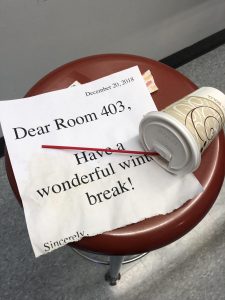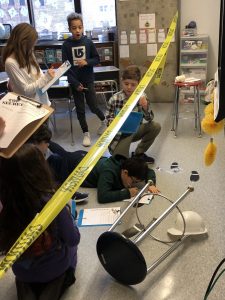
In Jensen Paterson’s class, students have been working on their inferencing skills. The room’s speech-language pathologist, Gabrielle Kawalick, helped to put together a creative “crime scene” that would allow students to use inference.
A mystery person came into Room 403 to leave a holiday note, but left a mess and a variety of clues behind including:
- A note with spilled coffee (inference: the culprit is probably an adult because they drink the most coffee)
- Shoe and paw prints with white hair attached (inference: the culprit probably has a white haired dog and stepped in the coffee after it spilled)
- A Gaynor hard hat (inference: it is likely an admin because they are the ones with those hats)
- A knocked over stool (inference: the culprit left in a hurry)
- A faculty lanyard without an ID (inference: the culprit works at Gaynor and didn’t want us to know who it was because they took their ID with them)

“The students were entirely engaged with the lesson and thrived with the interactive components, almost instinctually activating their inferencing abilities,” said Ms. Paterson.
The students used all of the clues to piece together who they thought it could be and why, conversing amongst themselves and some even took it a step further, trying to figure out how the event might have played out. They eventually came to the right conclusion of it being Dr. Gaynor.
Students finished the activity by writing a “crime report” to summarize their findings. “Ms. Kawalick and I were extremely impressed and are already brainstorming how to do this again, making it more complex and intricate. We were very proud of how they applied the skills they acquired through instruction to a real world scenario,” said Ms. Paterson.
